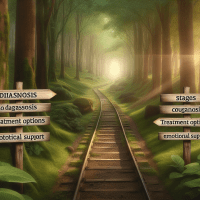How Asbestos Causes Mesothelioma: A Compassionate Journey
Hello, I’m a registered nurse with over 10 years of experience in oncology. I understand the deep emotional and physical impact of a mesothelioma diagnosis. This article is my personal, heartfelt effort to explain how asbestos causes mesothelioma while offering you compassion, accurate medical insights, and practical support on your journey. Together, we will explore the causes, diagnosis, treatment options, and emotional coping strategies in a clear, empathetic manner.


Understanding Asbestos Exposure and Mesothelioma
Asbestos is a group of naturally occurring minerals known for their resistance to heat and corrosion. Unfortunately, prolonged exposure—especially in industrial settings—has been closely linked to mesothelioma, a rare and aggressive cancer. I have witnessed firsthand how careless handling of asbestos can lead to life-changing diagnoses. When fibers are inhaled, they can become embedded in the lining of the lungs (pleura) or even the abdomen, eventually causing inflammation, scarring, and cellular mutations that may develop into mesothelioma.
This condition is distinguished not just by its physical impact but by the profound emotional toll it takes on patients and their families. I know that hearing “mesothelioma” can be overwhelming; it’s a term laden with anxiety and fear. My approach is always gentle and guided by accurate information, imparting hope and clarity amid uncertainty.
The Mechanism of Asbestos in Causing Mesothelioma
Once inhaled, asbestos fibers infiltrate the delicate tissues of the lungs and eventually lead to chronic inflammation. Over time, this inflammation can result in genetic damage. The body’s attempt to repair this ongoing damage may inadvertently lead to mutations in the cells of the mesothelial lining. Such mutations can pave the way for malignant growth. The process is gradual, and sometimes symptoms may only become apparent years or even decades after exposure.
Understanding these mechanisms not only clarifies the biology of mesothelioma but also underscores the importance of prompt diagnosis and care. I encourage everyone to consult reputable sources such as the National Cancer Institute or the American Cancer Society for further reading.
Diagnosis and Staging: A Critical Pathway
Finding clarity in the chaos of a mesothelioma diagnosis is essential. From my years working with patients, I’ve learned that understanding the diagnostic process can significantly ease the uncertainty. Typically, if mesothelioma is suspected, doctors will recommend imaging tests, blood tests, and various biopsy methods.
Biopsy Techniques and What to Expect
Biopsies are critical in confirming a mesothelioma diagnosis. Common methods include thoracoscopy, where a small camera is used to inspect the chest cavity, and thoracentesis, which involves draining and analyzing fluid around the lungs. Each technique has its benefits, and your physician will guide you towards the most appropriate option based on your unique situation.
Understanding the Mesothelioma Staging System
Staging helps gauge how far the cancer has spread. Generally, mesothelioma is categorized from Stage 1 (localized) to Stage 4 (advanced spread). This information is pivotal in determining treatment options and expected outcomes. I always recommend discussing these details thoroughly with your healthcare team to develop a personalized care plan.
Exploring Treatment Options and Research Developments
After diagnosis, the path to treatment begins. The range of treatment options for mesothelioma is continually evolving thanks to ongoing research and advances in medical science. As someone deeply involved in patient support, I encourage you to explore all available options while staying in close contact with your medical team.
Treatment typically involves a combination of surgery, chemotherapy, radiation, and emerging therapies like immunotherapy. For some, the focus may also include clinical trials that offer access to cutting-edge treatments. I have seen patients find hope in knowing that even if the diagnosis is daunting, there are multiple avenues for care and management.

How Treatments Work
Surgery can be employed to remove tumors when they are localized, while chemotherapy helps target cancer cells systems-wide. Radiation therapy works to destroy malignant cells in a focused area, and immunotherapy aims to harness the body’s own defenses to fight the cancer. Each option comes with its own set of benefits and potential side effects, which should be considered carefully with your medical team.
For those exploring the idea of combining treatments, many specialized centers offer integrated approaches. An internal resource on our site, Top-Rated Mesothelioma Treatment Centers, provides detailed insights into what you might expect from these options.
Emotional Support, Coping, and Resilience
Mesothelioma is not only a physical battle but also an emotional one. I have stood by many patients and witnessed the profound resilience that emerges in the face of this diagnosis. It’s important to remember that feeling overwhelmed, anxious, or fearful is a natural reaction. I want you to know that you are not alone on this journey.
Strategies for Managing Emotional Turbulence
Practical strategies can help ease the emotional burden. Regular communication with your care team, joining support groups, and possibly speaking with a mental health professional all contribute to navigating this difficult time. Mindfulness exercises, gentle physical activities, and even creative expression have been shown to reduce stress levels and promote mental well-being.
For immediate help, I always advise reaching out to local support organizations or calling a trusted helpline. Simple actions, like talking to someone who understands, can make a big difference in how you experience each day.
Communicating with Loved Ones
Open, honest communication with family and friends can help create a supportive environment. When discussing your condition, it may help to prepare a list of questions or key points, such as what treatments you are considering or how you’re feeling emotionally. Remember, transparency fosters understanding, and your loved ones want to share in your journey, even when it is hard.
Guidance for Next Steps and Available Resources
Now that we have explored the causes, diagnosis, treatment options, and the emotional aspects of mesothelioma, let’s look at practical next steps. I encourage you to review all your options and make appointments with specialists who have experience treating mesothelioma. If you are considering legal consultation about asbestos exposure, please note that such services are presented only as part of a broader support framework, ensuring you receive comprehensive care and understanding before any legal considerations.
Creating a Personalized Care Plan
Work closely with your medical team to create a care plan that addresses not only your treatment needs but also your emotional, physical, and social well-being. A holistic approach can sometimes include:
- A detailed schedule of medical consultations and treatments
- Regular mental health evaluations
- Participation in support groups or counseling sessions
- Engaging in light physical activity as recommended by your doctor
Seeking Additional Guidance
If you find this information helpful, I recommend exploring more detailed resources on our site. For example, our article on Understanding Mesothelioma Staging provides further insights into how diagnosis affects treatment options. Additionally, our piece on Navigating Treatment Options offers a deep dive into the available therapies and patient experiences.
Remember, you are at the heart of your care journey. Each step you take, whether it’s seeking more information, joining a support group, or talking to a specialist, is a testament to your strength.
Information on treatment guidelines current as of May 2025.
Final Words of Encouragement
I truly understand the struggles that come with mesothelioma—from the initial shock of diagnosis to the ongoing battle against uncertainty. My hope is to offer you a pathway forward filled with knowledge, practical steps, and heartwarming support. While the road ahead might seem daunting, know that every informed decision you make contributes to a future where hope and resilience prevail.
Your journey is unique, and you deserve care that addresses every aspect of your well-being. I am here to walk this path with you as an advocate, a guide, and a friend. May this article serve as a beacon of light and a reminder that you are never alone.






